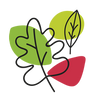Conversation VII
Or, some beautiful stitching with Ann-Marie Anderson-Mayes.

Lucky me, being introduced to Ann-Marie Anderson-Mayes. She’s a fellow traveller on the path of creativity whose life took a radical turn from geophysics to embroidery and she’s never looked back.
The following interview outlines her career transition and the passion she has for canvaswork (that’s Australian for ‘needlepoint’).
And I hope you will explore her blog – The Hands Manifesto – where she encourages us to pay more attention to the work we do with our hands, especially in the education system. She writes about everything from craft to cooking and I thoroughly enjoy reading her work. I hope you do too!

------------------
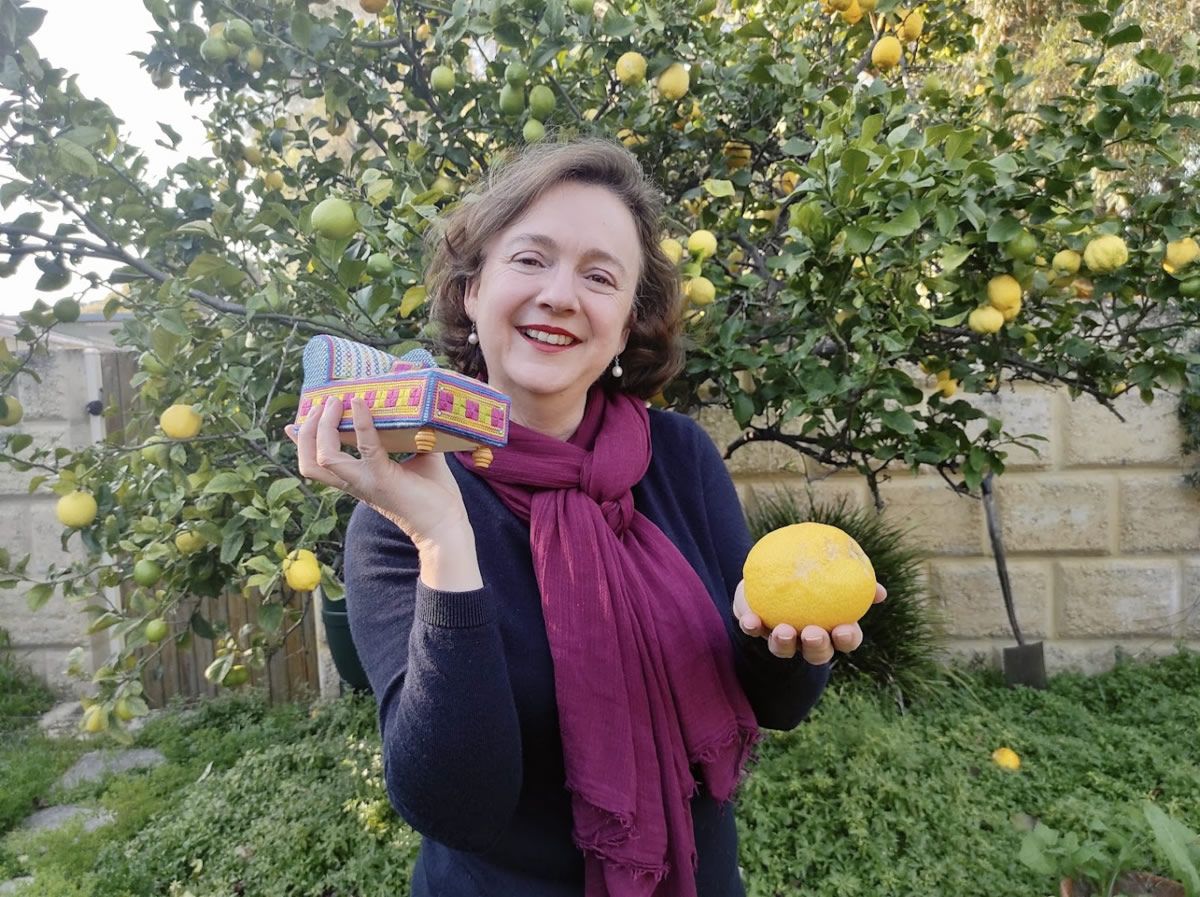
Hi Ann-Marie. Thanks for talking to me and sharing your amazing creations with us – it’s wonderful to have you on the blog.
Thank you so much for inviting me! I’ve loved reading your blog posts so it’s a genuine pleasure to be a part of it :)
Can you tell me how you started stitching? What drew you to this craft?
I’ve been stitching for as long as I can remember. It all started with my Mum. We moved a lot in my childhood, so there was a lot of change. One of the constants though was that there were always craft projects on the go in our home. Mum helped us try everything from candle making to macrame. We set bugs in resin, knitted, crocheted, sewed by hand and machine, painted and glued collages, made stuffed toys and tiny creatures out of gum nuts. One of my absolute favourites was embroidery and particularly cross stitch. I can’t really say what drew me to that craft specifically. It’s just so much a part of me that I can’t imagine my life without it!
And can you please tell us about your style of embroidery – its origins and what is involved in working in this style?
In Australia, we call my style of embroidery ‘canvaswork’ and in the US it’s called ‘needlepoint.’ The simplest way to describe it is to imagine that the base fabric is like a piece of graph paper with evenly spaced warp and weft threads. This ‘grid’ becomes the structure into which the stitches are placed, with the needle always being taken through a ‘hole’ in the fabric. It’s a very geometric style of embroidery which I sometimes refer to as ‘cross-stitch on steroids.’ I am constantly fascinated by the wide variety of designs that can be created by experimenting with thread type, colour and stitch layouts. There will never be enough time to stitch all the ideas I have in my head!
Canvaswork originated from covering coarse, poor-quality cloth with dense, closely spaced stitching to create something that completely covered the base fabric, making it much more hard-wearing. The style of stitching and the designs mimicked the much more expensive tapestries of the time. Like many forms of art and craft, it has changed substantially from those humble origins. Originally, the embroidery was worked in just a handful of basic, hard-wearing stitches to create utilitarian pieces like cushions and bed coverings. These days there are books that catalogue literally hundreds of stitches and most completed pieces are more decorative in nature.
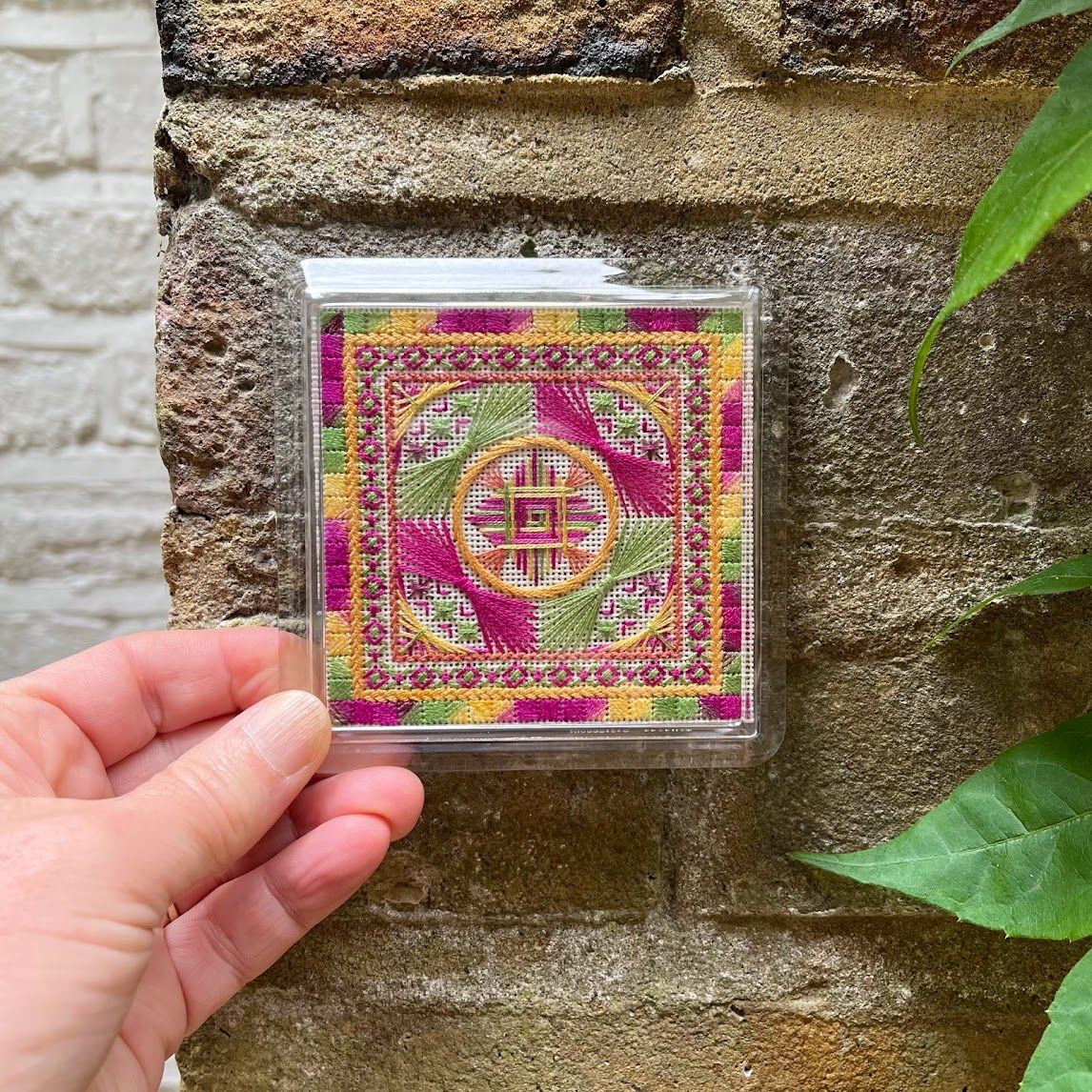
Before you embarked on a creative life, you had a career as a research scientist in physics and geoscience. Can you please tell us about the transition you made and how you started your business, Beautiful Stitches?
While my home life was dominated by making things, at school I really loved maths and science. Fortunately, these subjects came easily to me and at the time I had a particular passion for astronomy. The natural next step on the path was to study a BSc majoring in Physics. I started this at the University of Adelaide but for family reasons moved to the University of Western Australia at the end of my second year. Their astronomy program at the time wasn’t strong, so I found myself looking for other options. A summer job at an airborne geophysics firm set me off in a new direction which eventually led to me completing my Ph.D. in 1999, two weeks before my first child was born.
My husband was in the mining exploration industry, so we moved regularly, and I was focussed on my role as a mother to two small children. I absolutely loved the ten years I spent at home with them, but it left a very big hole in my science career. Technology had changed a lot, I didn’t have the confidence to believe that I could step back into the work I used to do, and I had no postdoctoral research to help me back onto the academic track. So I went looking for something new.
The love of craft and making things had never gone away. In fact, it was the one thing that kept me sane through all the moves and changes in my life. I began to wonder if I could make a business out of it. I had been doing some science writing work, but I wasn’t paid a salary, only an honorarium. I was pretty sure that I could make the same amount of money running my own craft business, so I eventually rustled up the courage and jumped off into the unknown.
I started Beautiful Stitches in July 2012 to share my passion for embroidery. My first classes were for children, which I loved. Children aren’t afraid of creativity. Give them some materials and a loose idea (e.g. “today we are making a book cover”) and they run with it. I saw my job as simply scaffolding their stitching skills so that they had the best chance possible of transforming the idea in their head into something real. It was challenging because I had to think on my feet all the time. How do you stitch a picture of a horse with wings in three hours? But I learned a lot from their uncomplicated, enthusiastic approach to my classes. Soon after I began teaching adults too, and my business has grown steadily ever since.
How would you describe your creative practice? What is involved in creating a new piece? I’m interested in the way that you make patterns too. Can you please tell us a little about that?
This is such an interesting question because it goes to the heart of my core philosophy. I believe that everybody is creative – you just have to find the materials or processes that you love to work with. For me it happens to be needle and thread. For someone else it might be software, or words, or food, or metal. Once you have found the processes that you love, then you build creative experiences that develop your particular style. Given the opportunity, every single person on the planet is capable of it.
I like to design from the outside in. In other words, I know the size and shape of a piece from the very beginning. Sometimes it’s a flat design and sometimes it’s a three-dimensional piece like one of my model chairs. Working the defining borders first is relatively easy and quite repetitive, so this is a good time for me to think about what I will do next. Will the design be totally symmetrical? Will I further subdivide it into smaller areas? Do I have some new stitch combinations I would like to try? I let my mind wander around these ideas whilst working on the foundations for the piece.
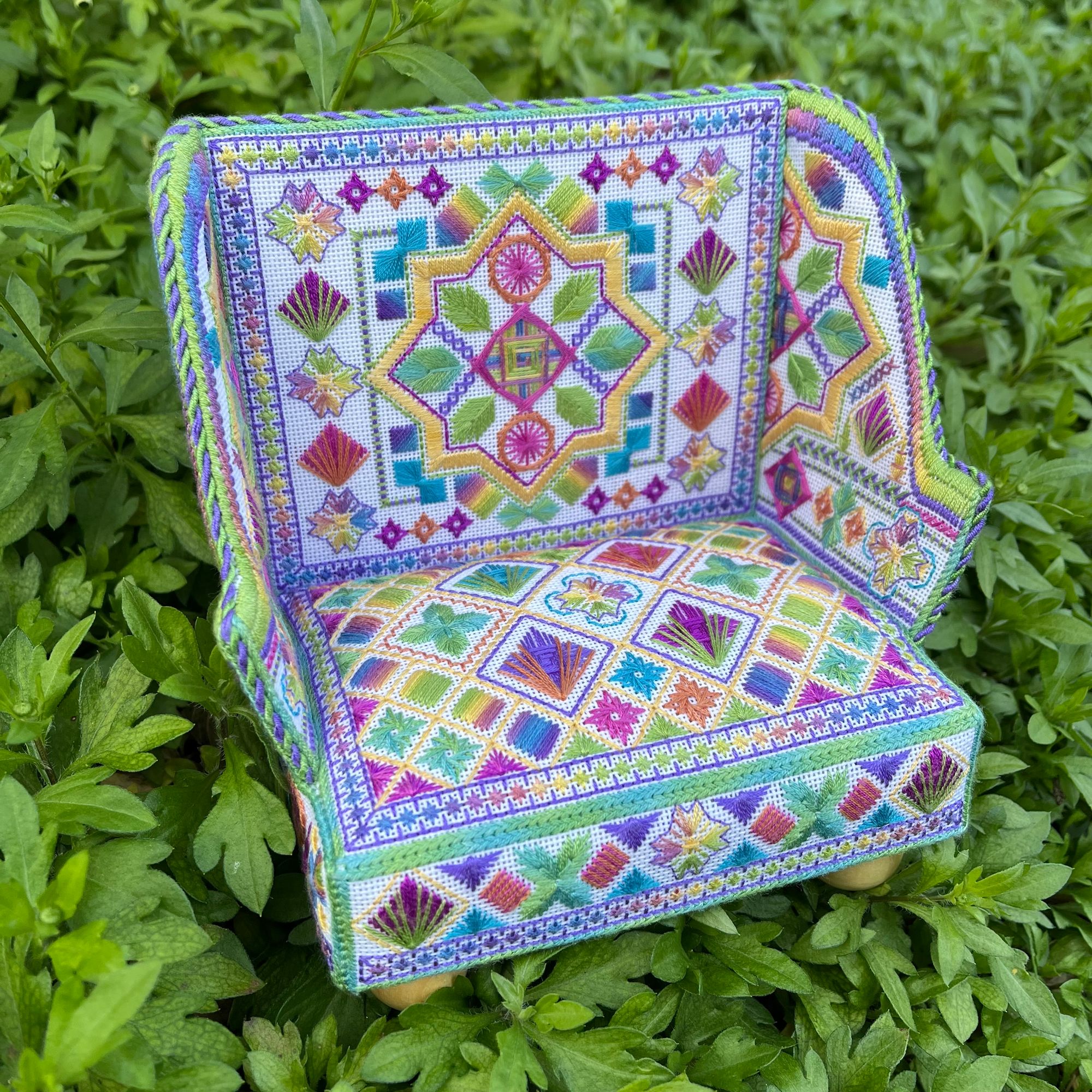
And then I just start playing. I almost never chart out ideas in advance. I simply start filling the space with stitches. It’s fun for me because I never know quite how a piece is going to turn out. There is often some reverse stitching, known as ‘frogging’ in the embroidery world. Perhaps a colour combination doesn’t quite work or the stitch balance is off. But as I often teach my students, I’m never in a hurry to take something out. I’ve learned that what looks like an imbalance in a partially completed motif can often be fixed by what you add to it, rather than by what you take away.
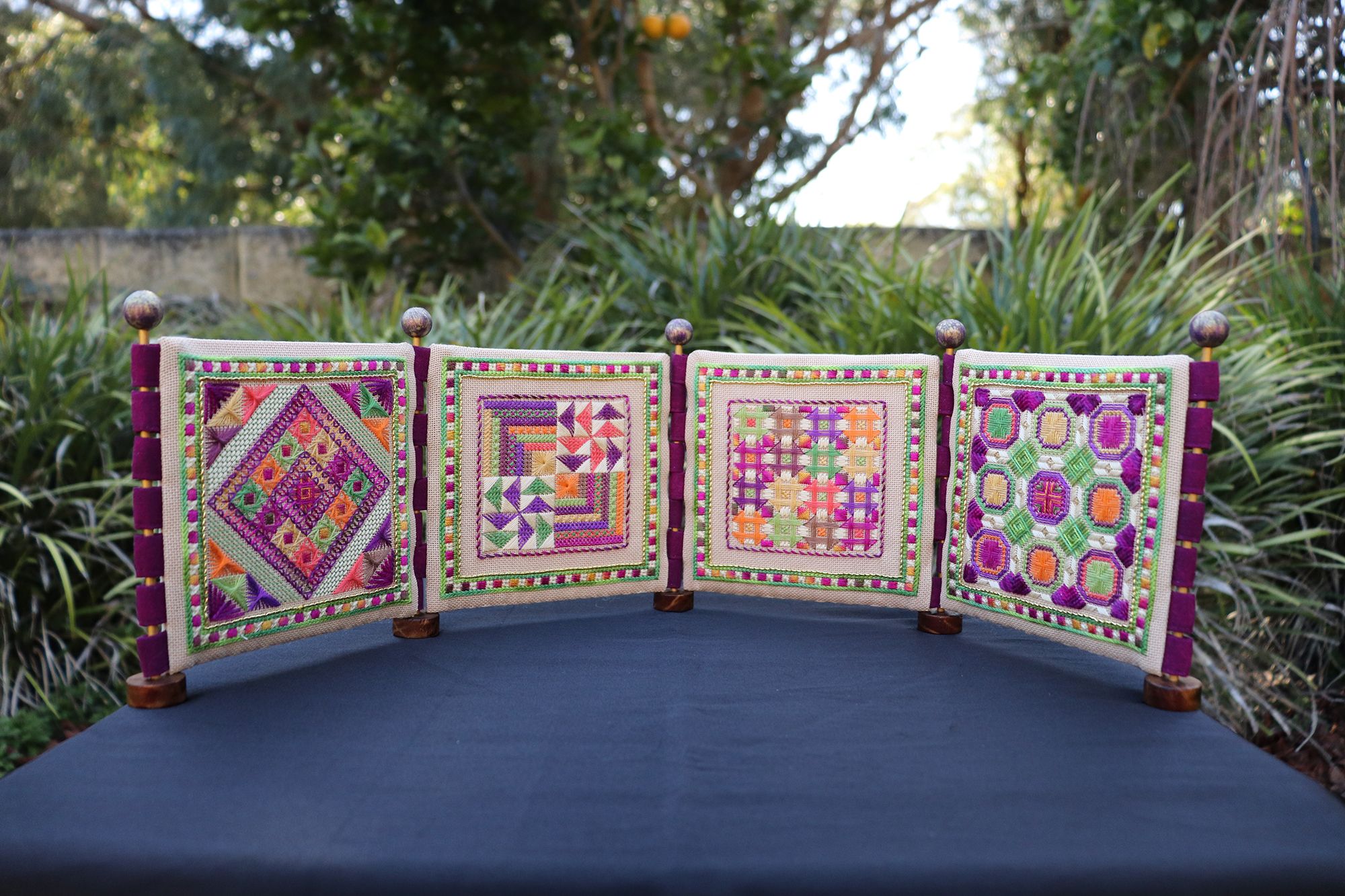
My patterns are created using the Adobe Creative Cloud suite. It’s one of my biggest business expenses but totally worth the investment. My science training means that I write patterns so that everything is as clear as I can possibly make it. I want my students to pick up a pattern six months after doing a workshop with me and confidently restart where they left off. So my written notes align with charts and stitch diagrams. It comes down to following a set of instructions that enable my students to literally stitch by numbers: bring the needle up at ‘1’, down at ‘2’, up at ‘3’, etc.
You teach people stitching too – can you please tell us what that process is like? What can people expect when they join one of your classes?
I have three different teaching modes. First, I have been teaching a weekly class in Perth since 2014. These run for three hours on a Friday morning and students work on whatever stitching project they like. My role is simply to be a creative guide and facilitator. Some people come for a term (eight classes) and some have been coming for years. It’s one of the highlights of my week.
Second, I teach short 1-, 2- and 3-day workshops at various venues around Australia. These classes are project specific. Students learn all the stitches needed to complete a given design, but they rarely finish everything in class. Normally it will take a few weeks or months to finish the project at home in their own time. I love helping students to grow their own creative confidence, so I encourage people to play with colours and even change stitches in my designs. There is no right or wrong in my classes.
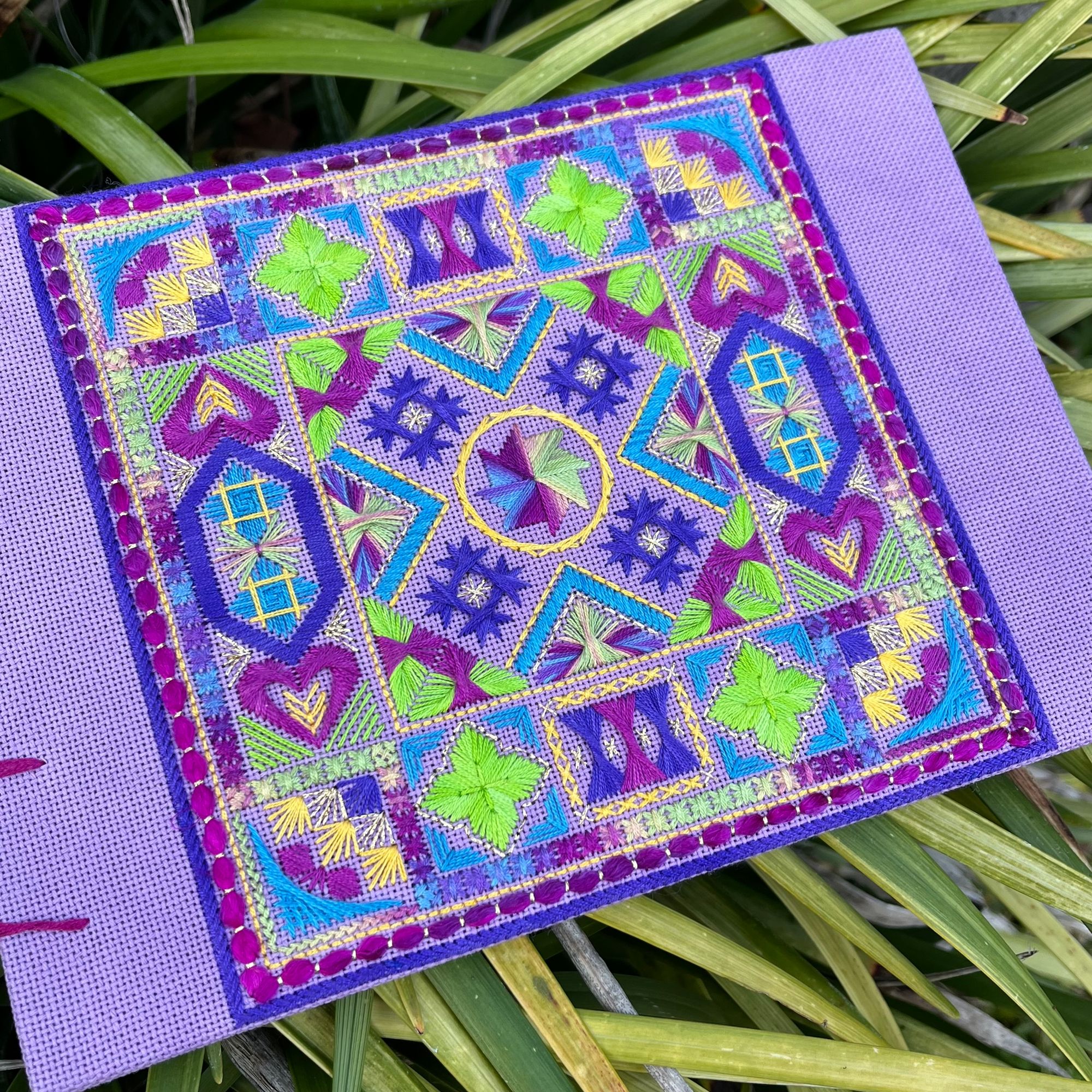
Finally, since the pandemic, I’ve started my online teaching platform. This enables me to reach a much wider audience and teach larger designs than I can cover in a typical 2- or 3-day workshop. I’ve been offering these as Block of the Month projects. Each month, students receive all my usual notes and charts, but also videos that walk them through everything, just as though they were in a classroom with me. The advantage of course, is that they can replay a stitch demonstration as many times as they need.
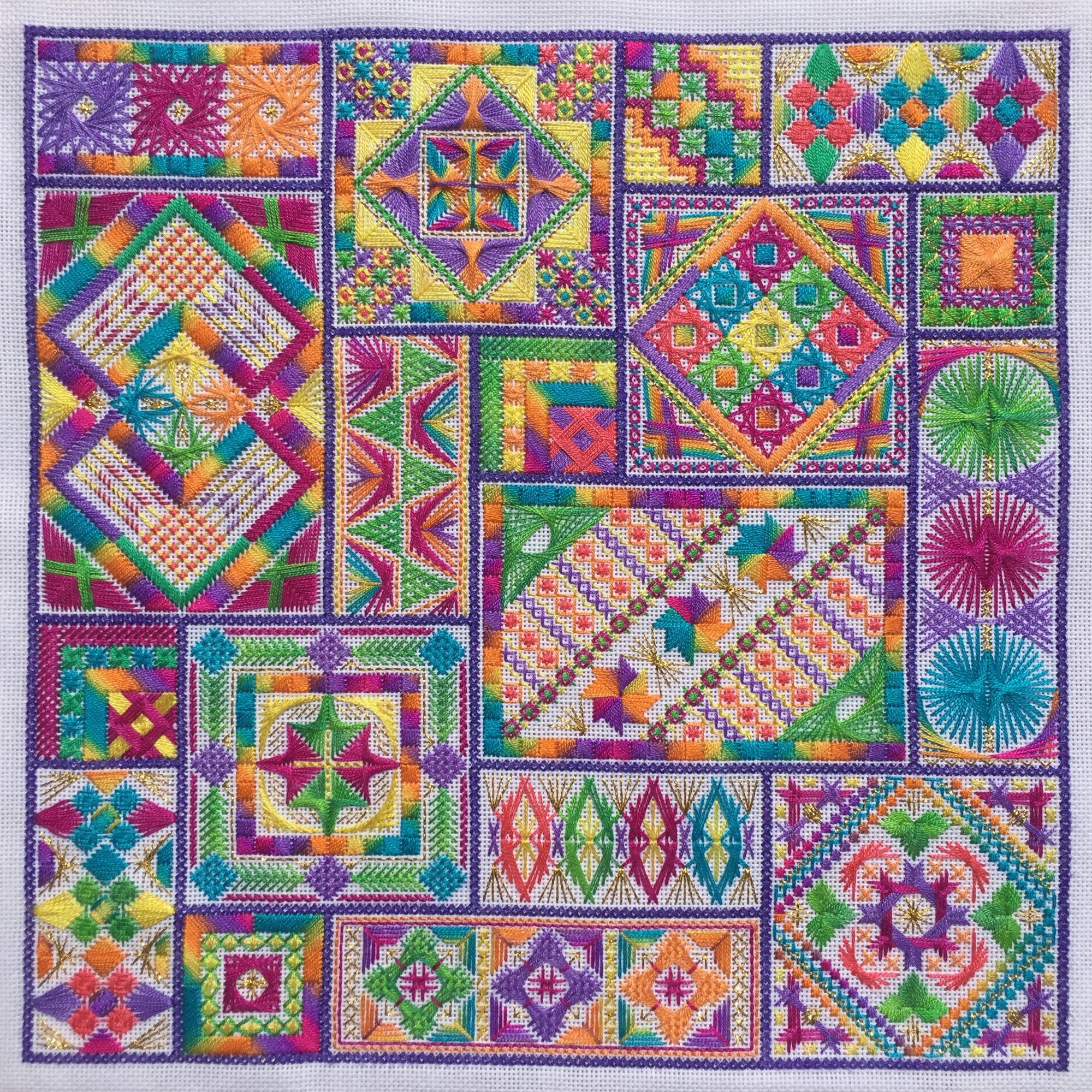
You’ve recently started a website called The Hands Manifesto. Your desire is to help the world understand the joy of the connection between hands and brains, especially teachers and those working in education. Can you please tell us about the philosophy behind the Hands Manifesto and what you’d like to achieve?
I’ve been teaching embroidery for over ten years now. In that time, over and over again, I’ve seen something magical happen when people stitch together. I’ve watched confidence grow in individuals as their hands become more adept at wielding needle and thread. I’ve seen extraordinarily open, honest and vulnerable conversations take place when people are stitching together. I’ve witnessed students for whom stitching becomes an integral part of managing mental health issues or chronic pain.
I started doing some research and found that other creative practitioners have observed the same things. It doesn’t matter whether they are making wooden surfboards in Cornwall, or knitting in Sweden, or throwing pots in a craft school in the US. All those creatives report the same kinds of outcomes in their own work and teaching. There is also a growing body of cognitive research that shows that our hands and brains are intricately connected. We learn with our hands just as much as we learn with our brains, and yet in our educational and social systems, cognitive work is generally rated much more highly than manual work. I think there is a critical imbalance there that needs to be addressed.
The Hands Manifesto, in this early phase, is a place to explore ideas. I think we need to raise the profile of hand work. I don’t want any child in any school to think they are somehow ‘less’ because they are more skilled in the wood workshop than they are in the maths classroom. Equally, I don’t want a young person who writes good essays to think that a cooking or jewellery-making class is a stupid waste of their time. I want to see a society where we value manual labour and cognitive labour equally – in education, in careers, and in life. I want people to be more aware of the power of hand-based activities to improve thinking, wellbeing and mental health.
As I go further into this journey, I’m realising that we have a uniquely personal and deep connection with our own hands and those of the people around us. Our hands carry the power of creativity, love, and care. We touch, we feel, we make, we learn, we reach out, we carry, we grasp, we hold on, we open, and we close. Our hands do all these things, they express all these things, and they communicate these things with our brain and thus with the rest of our body. I want to make sure that we don’t forget just how amazing and important they are.
What’s next for Ann-Marie? Where would you like this creative journey to take you?
The last ten years have been utterly extraordinary for me. I have been on an amazing but totally unexpected journey of personal growth. In the beginning, I thought I just wanted to be an embroidery teacher. It turns out that embroidery happens to be my vehicle for exploring much wider ideas around creativity, wellbeing and education. My life as a creative has taught me that life is all about the journey and not the destination. So, I don’t know what’s next. I’ll just keep doing the work that I love, sharing that passion with my students, and researching the ideas that these processes spark. I know without the shadow of a doubt that this open-ended approach to my life will throw up new surprises, and I can’t wait to see what they are.
